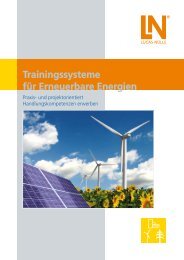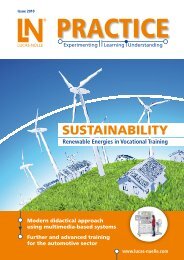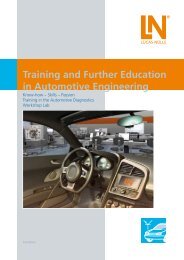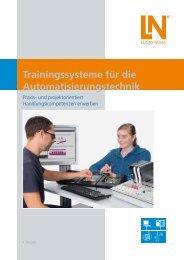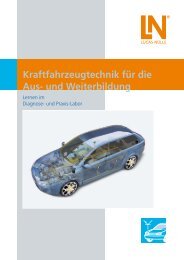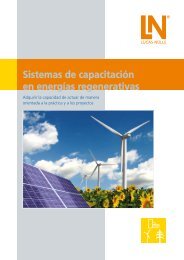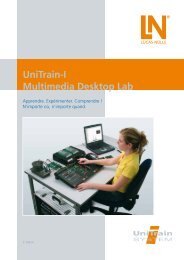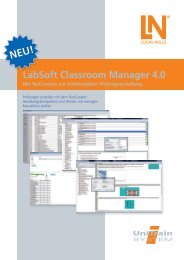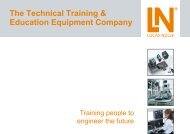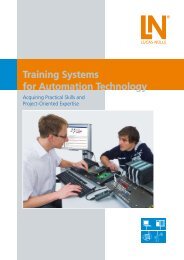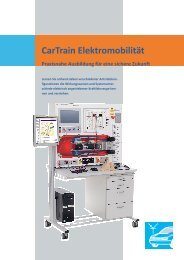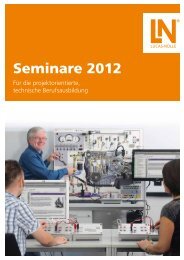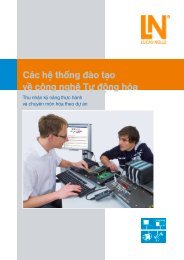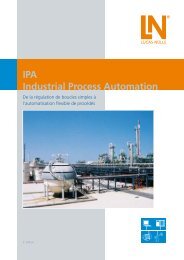Communications Technology - Lucas-Nülle
Communications Technology - Lucas-Nülle
Communications Technology - Lucas-Nülle
Create successful ePaper yourself
Turn your PDF publications into a flip-book with our unique Google optimized e-Paper software.
ContentsQualifications Through QualityTraining Systems for Telecommunications Engineering ............................................................................................................. 4The UniTrain-I System – Combining Theory and Practice at the Same Time and PlaceUniTrain-I – Multimedia Laboratory with 30 <strong>Communications</strong> <strong>Technology</strong> Courses .................................................................. 6Animated Presentation of Complex Training ContentProject-oriented Training Media – Adaptable to Any Training System ....................................................................................... 8Entire System at a Glance .................................................................................................................................................. 10More Than Just a Training SystemThe <strong>Communications</strong> <strong>Technology</strong> Laboratory is a Complete Solution ..................................................................................... 12
ContentsBasic Modules for Telecommunications Engineering ................................................................................................. 14-21Quadripoles and FiltersElectromagnetic CompatibilityOperational AmplifiersConverter CircuitsTransmission Lines ........................................................................................................................................................ 22-31Four-wire LinesCoaxial CablesFibre-optic WaveguidesMicrostrip LinesMicrowave <strong>Technology</strong>Waveguide ComponentsModulation Methods and Multiplexing <strong>Technology</strong> .................................................................................................. 32-39PAM / PCM / DELTA Pulse Modulation MethodsPTM Pulse Modulation MethodsASK / FSK / PSK Modem MethodsModulationTransmission and Receiving <strong>Technology</strong> ..................................................................................................................... 40-49Antenna <strong>Technology</strong>Complex Antenna SystemsTransmission and Receiving <strong>Technology</strong>RFIDDigital Signal Processing .............................................................................................................................................. 50-55Digital Signal ProcessingApplied Digital Signal ProcessingNetwork <strong>Technology</strong> ..................................................................................................................................................... 56-61TCP/IP Network <strong>Technology</strong>Network <strong>Technology</strong> Client IntegrationVoice over IP .................................................................................................................................................................. 62-67Hands-on Technical Practice in Telecommunications <strong>Technology</strong> .............................................................................. 68-77Technical Practice in TelephonyTechnical Practice on NetworksWLAN SOHO TrainerWLAN Bridgelink Radio TrainerVoIP/ISDN/POTS Monolith / Modular Trainer
Qualifications Through QualityTraining Systems for Telecommunications EngineeringTechnological Progress …The ever-increasing amount of information being transmitted is pushing development in telecommunications engineering towardhigher and higher operating frequencies, which permit considerably greater bandwidths and thus make faster data processing possible.The information itself is being conveyed via radio links, copper cables, fibre-optic cables, waveguides and microstrips.4<strong>Lucas</strong>-<strong>Nülle</strong>
… Is Having a Huge Impact on Training and EducationDue to the fact that telecommunications technology is becoming more and more complicated and sophisticated, it is necessary to finda way of dealing with this in training and education. This is the only way to ensure that trainees and students are constantly beingprepared for tomorrow’s complex world of work using state-of-the-art technology.<strong>Lucas</strong>-<strong>Nülle</strong>5
The UniTrain-I System – Combining Theoryand Practice at the Same Time and PlaceUniTrain-I –Multimedia Laboratory with 30 <strong>Communications</strong> <strong>Technology</strong> CoursesThe multimedia-based experiment and training system UniTrain-I guides the student through experiments and theoretical sectionswith clearly structured course navigation and software that also includes texts, graphics, animations and tests.In addition to the training software, the courses also contain experiment cards on which practical exercises are performed. Coursesare included on such topics as “transmission lines”, “antenna technology” and “digital signal processing” which convey all of theknowledge and skills needed for the understanding, configuration, trouble-shooting and deployment of modern telecommunicationstechnology. With the aid of animations and a host of experiments on real modules and systems, the various courses explore thefundamentals, principles and component properties used in transmission and receiving technology, modulators and demodulators,AD and DA converters and permit the required measurements to be carried out.Your benefits• All the topics involving communications technology areavailable• Theory and practice are combined at the same time andplace• High student motivation thanks to PC and modern mediawork environment• Rapid learning success thanks to structured course navigation• Quick understanding thanks to theory-supporting animation• Acquisition of skills through own experimenting• Continuous feedback thanks to comprehension questionsand tests• Guided trouble-shooting using an integrated fault simulator• Safety guaranteed thanks to the use of extra-low voltage• Sample solutions6<strong>Lucas</strong>-<strong>Nülle</strong>
UniTrain-I system• Complete, portable laboratory• Multimedia courses• High-tech measurement andcontrol interface• Combines theory and practiceat the same timeUniTrain-I interface with USB• Oscilloscope with 2 analogdifferential inputs• Sampling rate 40 Msample/s• 9 measurement ranges 100mV – 50 V• 22 time ranges 1 μs – 10 s• 16 digital inputs and outputs• Function generator up to 1 MHz• 8 relays for fault simulationUniTrain-I experimenter• Receptacle for experimentcards• Experimenter voltage± 15 V, 400 mA• Experimenter voltage 5 V, 1 A• Variable DC and three-phasesource 0 ... 20 V, 1 A• IrDa interface for multimeter• Additional serial interface forcardsIntegrated measuring instrumentsand power supplies• Multimeter, ammeter, voltmeter• 2-channel storage oscilloscope• Function and waveformgenerator• Spectrum analyser• Bode plotter• ... and many more instrumentsbesidesTraining and experiment softwareLabSoft• Large selection of courses• Comprehensive theory• Animations• Interactive experiments withinstructions• Free navigation• Documentation for measurementresults• Test<strong>Lucas</strong>-<strong>Nülle</strong>7
Animated Presentation ofComplex Training ContentProject-oriented Training Media – Adaptable to Any Training SystemMultimedia coursesMany experiment instructions are available as multimediacourses. These allow direct access to the measurement resultsof various equipment. Multimedia courses contain the following:• Questions to monitor knowledge level and learning• Interactive experiment set-ups• Navigation bars• Animated sections devoted to theoryPresentation slidesPresentation slides can provide support for your lessons, e.g.supplying background information, block circuit diagrams,physical fundamentals, specific standard characteristics, specialmodifications and application examples. The set of slides isprovided in PowerPoint format.8<strong>Lucas</strong>-<strong>Nülle</strong>
Entire System at a GlanceTechnical PracticeTelecommunications<strong>Technology</strong>TTT 1P / TTT 2P / TTT 4P / TTT 6Pequipment setsInstallation of analog and digital telephonetechnology in the SOHO rangeTPN1 equipment setInstallation of a CAT 5 networkMultimedia CoursesTelecommunicationsNetworksCourse SO2700-1BTelecommunications networksCourse SO2700-1ATelecommunications networksCourse SO2700-1CISDNVoIPSO3538-4W equipment setVoIP-Trainer-LiteLM9994 equipment setMeasurements and fault diagnosticsin the VoIP networkNetwork <strong>Technology</strong>Digital Signal ProcessingTransmission andReceiving <strong>Technology</strong>Course SO4204-9XComplex antenna systemsCourse SO4204-9WAntenna technologyCourse SO4204-9NTransmission and receiving technologyModulation Methodsand Multiplexing<strong>Technology</strong>Course SO4204-9JPulse modulation methodsPAM/PCM/Delta modulation,AMI/HDB3 codingCourse SO4204-9KPulse modulation methods PWM, PPMTransmission LinesCourse SO4204-9FFour-wire linesCourse SO4204-9DCoaxial linesBasic Modules of<strong>Communications</strong>Engineering10Course SO4204-9AQuadripoles and filtersCourse SO4204-4KElectromagnetic compatibility<strong>Lucas</strong>-<strong>Nülle</strong>
TTK2020 equipment setInstallation of a WLAN wireless lineTTK2010 equipment setInstallation of a WLAN networkTTK1010 / TTK1011 equipment setPutting a POTS-ISDN telecommunications system into operation,Putting a VoIP telecommunications system into operation,Smooth migration to VoIPCourse SO2700-1DGSMCourse SO4204-9RNetwork technology client integrationCourse SO4204-9QNetwork technology TCP/IPCourse SO4204-6QApplied DSPCourse SO4204-6PDigital signal processingCourse SO4204-9SData acquisition with RFIDCourse SO4204-9LModem methods ASK, FSK, PSKCourse SO4204-9MAnalog modulation AM, DSB, SSB, FMCourse SO4204-9VWaveguide componentsCourse SO4204-9EFibre-optic waveguidesCourse SO4204-9YMicrostrip linesCourse SO4204-9UMicrowave technologyCourse SO4204-5MOperational amplifiersCourse SO4204-6FA/D and D/A converters<strong>Lucas</strong>-<strong>Nülle</strong>11
More Than Just a Training SystemThe <strong>Communications</strong> <strong>Technology</strong> Laboratory is a Complete SolutionAnimated presentation of complex trainingcontent using modern mediaPractical technical expertiseTelecommunications technology12<strong>Lucas</strong>-<strong>Nülle</strong>
Laboratory communication systemswith networked workstationsMicrowave technologyMultimedia-based training andeducation using UniTrain-IAntenna technology<strong>Lucas</strong>-<strong>Nülle</strong>13
Basic Modules for TelecommunicationsEngineeringBasic Practice-oriented Know-how .......................................... 16Quadripoles and Filters ............................................................ 18Electromagnetic Compatibility ................................................. 19Operational Amplifiers ............................................................ 20Converter Circuits ................................................................... 21
Basic Modules for Telecommunications EngineeringBasic Modulesfor Telecommunications EngineeringBasic Practice-oriented Know-howA well-grounded training in the fundamentals of telecommunications is the prerequisite for understanding complex relationshipsfound in various application areas. Our training systems are especially designed for the needs of practice-oriented training of bothtechnicians and engineers. The fundamentals of telecommunications engineering are explored and graphically depicted using manyexamples, explanations, exercises and practical assignments.16<strong>Lucas</strong>-<strong>Nülle</strong>
Basic Modules for Telecommunications EngineeringSignal Processing and ConditioningModern signals in telecommunications technology consist of abroad spectrum of frequencies and are often subject to noise.In order to be able to recover the information from the signal, ithas to be processed with filters and subsequently amplified.Analog-digital and Digital-analog ConversionInformation transmission and processes normally take place inan analog world. The signals being transmitted and processedby modern telecommunications systems are for the most partdigital. These systems need analog-digital and digital-analogconverters to convert these signals.Equipment Operates in a Reciprocal ContextMore and more varied telecommunications equipment andmod ules are being used in ever more restricted space. This canlead to system interference and distortion.<strong>Lucas</strong>-<strong>Nülle</strong>17
Basic Modules for Telecommunications EngineeringQuadripoles and FiltersHigh-pass/Low-pass – Bandpass/Bandstop – Band Filters –Series and Parallel Resonant CircuitsIn telecommunications technology, filter or filtering circuits are used in a wide range of applications in suppressing or attenuating frequencyranges in the signal. In expressing transfer response it is primarily the two quadripole parameters, transfer function and phaseresponse, which are of interest.Training contents• Transfer function phase response and cut-off frequency• Transfer function in the complex plane• Transfer function, phase response and cut-off frequency of high- and low-pass filters with Bode plot• Transfer function, bandwidth and medium frequency of band filters with Bode plot• Resonant circuit: transfer function, bandwidth, determining quality and resonance frequency• Analysis of resonant circuits with the aid of Bode diagrams• Parallel resonant circuit with capacitance diode tuning18UniTrain-I Course SO4204-9A<strong>Lucas</strong>-<strong>Nülle</strong>
Basic Modules for Telecommunications EngineeringElectromagnetic CompatibilityEMC Models – Standards and Regulations – Coupling MechanismsAspects of electromagnetic compatibility of a circuit play an important role in both circuit development and fault analysis. Most importantlythis involves both coupling effects inside the circuit as well as interference, which can penetrate the circuit from outside or whichemanates from the circuit itself.Training contents• Introduction to EMC• Basic terms and definitions• EMC influence models• Sources of distortion• Standards and regulations• Coupling mechanisms• Remedial measuresUniTrain-I Course SO4204-4K<strong>Lucas</strong>-<strong>Nülle</strong>19
Basic Modules for Telecommunications EngineeringOperational AmplifiersBasic Circuitry – Precision Power Supply Sources – Active FiltersOperational amplifiers have come to play a significant role in analog electronics. As highly integrated and multi-functional componentsthey constitute a critical component in electronics training.Training contents• Design and operation of operational amplifiers• Circuit diagram and basic types of operational amplifier circuits• Determination of the parameters and limiting values of an operational amplifier by means of measurement:frequency response, gain• Investigation of typical analog computation circuits: adders, subtractors, integrators and differentiators• Set-up and measurements on precision voltage sources and constant current sources• Set-up and measurements on typical application circuits:impedance converter, precision rectifier, comparator and Schmitt trigger• Investigation of active filter circuits• Fault simulation20UniTrain-I Course SO4204-5M<strong>Lucas</strong>-<strong>Nülle</strong>
Basic Modules for Telecommunications EngineeringConverter CircuitsA /D and D/A Converters – f/U and U/f ConvertersA/D and D/A converters form the interface between the real world and the world of digital data processing. They are deployed inalmost every area of electrical engineering and electronics and thus have an important role in training and education.Training contents• Design and operation of D/A converters (R-2R network, weighted resistors)• Static and dynamic recording of D/A converter characteristics• Investigation of a D/A converter circuit of loudness control• Design and operation of A/D converters (pulse-counting methods, dual-slope methods)• Design and operation of U/f and f/U converters• Measuring the internal signals and recording their characteristics• Tuning the reference voltage for U/f and f/U converters• Fault simulationUniTrain-I Course SO4204-6F<strong>Lucas</strong>-<strong>Nülle</strong>21
Transmission LinesFour-wire Lines ........................................................................ 26Coaxial Cables ........................................................................ 27Fibre-optic Waveguides ........................................................... 28Microstrip Lines ....................................................................... 29Microwave <strong>Technology</strong> ............................................................ 30Waveguide Components ......................................................... 31
Transmission LinesTransmission LinesAre You Wired?Transmission lines are the arteries of telecommunications systems. The technically appropriate design and the correct choice ofcomponents in a transmission line are paramount for the proper operation of the entire system. The functions and application areasof transmission lines are explored here with didactically adapted training systems using typical components as well as conventionalcables and waveguide operating elements.24<strong>Lucas</strong>-<strong>Nülle</strong>
Transmission LinesCopper LinesCoaxial and four-wire lines are still very widely used and areoften the best solution in terms of price for a transmission link.Our UniTrain-I course explores and explains what makes suchtransmission media so outstanding and in which applicationsoptimum use can be made of them.Optical FibresEver-rising bandwidths and increasing clock frequencies requiresuitable transmission lines to be found. For these cases, clearpreference goes to fibre-optic waveguides.Radio Frequency <strong>Technology</strong>The higher the frequency of a signal, the smaller the wavelengthbecomes and thus makes the deployment of conventional componentsand cables more complicated. Microstrip lines are beingused more and more in efforts to pack integrated functionalityonto the increasingly smaller spaces of printed circuit boards.Normally waveguides are used in order to convey signals ofhigher frequency at high power levels.<strong>Lucas</strong>-<strong>Nülle</strong>25
Transmission LinesFour-wire LinesFour-wire Lines – Backbone of Every Telecommunications Network –Quantities per Unit Length – Near and Crosstalk – MatchingThe classic two- and four-wire line is still the most commonly used line for the connection and cabling of telecommunicationsnetworks. As a rule, be it an analog or a digital connection terminal, the last mile to the end user is a four-wire line.Training contents• Measuring the quantities of unit length at various frequencies using a measurement bridge• Measuring pulse transit on the conductor pair as well the individual wires with respect to ground• Demonstration of the pulse transmission or distortion in the case of faulty line termination• Measuring the line’s pulse reflection factor when the line has been incorrectly terminated26UniTrain-I Course SO4204-9F<strong>Lucas</strong>-<strong>Nülle</strong>
Transmission LinesCoaxial CablesQuantities per Unit Length – Characteristic Impedance –Matching – ReflectionsBy far the biggest volume of signal and data transmission goes via terrestrial media, i.e. via cables. In spite of relatively low technicalcomplexity in comparison to wireless transmission, practical usage is still not free of problems which arise due to the wrong choice ofcable materials or faulty matching at the coupling points.Training contents• Resistance, capacitance and inductance per unit length and characteristic impedance of a coaxial cable• Determination of:- Resistance per unit length using a Wheatstone bridge- Capacitance per unit length using a Wien bridge- Inductance per unit length using a Maxwell bridge- Characteristic impedance of a coaxial cable• Investigating reflections on a coaxial cable as a function of the line termination• Terminating a line correctly so that no more reflections occurUniTrain-I Course SO4204-9D<strong>Lucas</strong>-<strong>Nülle</strong>27
Transmission LinesFibre-optic WaveguidesOptical Transmission Links – Fibre-optic Waveguides – AttenuationsThe constantly expanding availability of information and data calls for ever-greater transmission rates. The result is that more and morefibre-optic transmission links are coming into use both in industrial applications as well as in communications engineering networks.Training contents• Principles of optical telecommunications• Components used in optical telecommunications• Advantages and disadvantages of optical transmission links• Characteristics and frequency response of infra-red emittingdiodes• Modulation methods for analog and TTL signals• Influence of different wavelengths on the transmissionresponse• Configuring a fibre-optic waveguide• Influence of the receiver diode on signal recovery• Determining the bandwidth of a fibre-optic transmission link• Influence of the input capacitance on the bandwidth andthe wavelength on attenuation• Comparing properties of step index fibres and gradientindex fibres28UniTrain-I Course SO4204-9E<strong>Lucas</strong>-<strong>Nülle</strong>
Transmission LinesMicrostrip LinesFrom Outer Space to Your Cell PhoneThe manufacture of integrated RF circuits on a semiconductor basis was only made possible by advances in microstrip technology.Planar waveguides have established themselves in a plethora of applications over the last two decades.Training contents• Design and operation of planar microstrip lines- Substrate materials- Calculation of line parameters- Line forms- Field distribution on the lines• Microstrip components- Directional coupler and Wilkinson divider- Dispersion matrix- Standardisation- Recording the transfer function• 90° and 180° hybrid coupler- Investigation of the transfer function- Measurement of the reflection factor• Microstrip line filter- Low-pass of the 3rd and 5th order- Bandpass (edge-coupled filter)- Bandstop (butterfly element)• Investigation of complex microstrip circuitry- Amplifier designed in MMIC technology- Low-noise FET amplifierUniTrain-I Course SO4204-9Y<strong>Lucas</strong>-<strong>Nülle</strong>29
Transmission LinesMicrowave <strong>Technology</strong>Simple to Operate Thanks to the Integrated InstrumentationWhether it be radar technology, satellite technology or even in mobile radio, microwaves are critical to signal transmission. The signalfeed to the transmission and receiving antenna is carried out for the most part using waveguides.Training contents• Line propagation theory and line parameters• Gunn oscillator: recording the current-voltage characteristic• Slotted lines• Reflection, standing wave ratio and matching• Measurement of wave propagation inside the waveguide, standing wave diagrams• Waveguide dimensioning and operating frequency• Shorting the waveguide termination, wavelengths• Measuring the effects of dielectrics30UniTrain-I Course SO4204-9U<strong>Lucas</strong>-<strong>Nülle</strong>
Transmission LinesWaveguide ComponentsExperimenting with Different Waveguide ComponentsTo assemble the complex microwave circuits found in waveguide technology, special components such as couplers, circulators or multiportsare required. Using these components the desired circuit function can be realised.Training contents• Become familiar with waveguide elements for changingdirection: rotary coupling, E- and H-plane bends• Determine the characteristic of a variable attenuator• Design and operation of a waveguide phase shifter• Measurement of the phase shift in the waveguide• Measurement of the attenuation and insulation of aferrite valve• Measurement of the attenuation and reflection of crosscouplers,directional couplers and ferrite circulator• Measurement of the insertion and coupling attenuation• Modulation and demodulation of microwaves inwaveguides• Examining a PIN modulator by means of measuringinstruments• Line characterisation using the Smith chart• Line matching using a slotted impedance adapter• Investigating the microwave signal at the waveguide’sopen endUniTrain-I Course SO4204-9V Supplement to SO4204-9U<strong>Lucas</strong>-<strong>Nülle</strong>31
Modulation Methods andMultiplexing <strong>Technology</strong>PAM / PCM / DELTA Pulse Modulation Methods....................... 36PTM Pulse Modulation Methods .............................................. 37ASK / FSK / PSK Modem Methods............................................ 38Modulation ............................................................................. 39
Modulation Methods and Multiplexing <strong>Technology</strong>Modulation Methods andMultiplexing <strong>Technology</strong>Analog and Digital Modulation – Coding – Time Division MultiplexingModulation methods and various types of signal coding form the basics of virtually every system in telecommunications. The mostimportant of these are the digital forms of modulation. They have gone on to dominate a vast number of the most varied of areas –from wireless to radio transmission – satellite transmission or mobile radio.34<strong>Lucas</strong>-<strong>Nülle</strong>
Modulation Methods and Multiplexing <strong>Technology</strong>Analog ModulationUseful analog signals include, for example, voice, music or videosignals. An essential property of analog modulation technologiesis the continuity of the modulation both in terms of time as wellas signal value. This is because analog modulation methods processthe useful signal continuously, i.e. there is no digitisation ofthe transmitted signal into discrete values. Analog modulationmethods can be broken down into two main groups:amplitude modulation and angle modulation (phase and frequencymodulation or PM and FM)Digital ModulationSome digital modulation technologies correspond to theiranalog counterparts or have been derived therefrom. However,there are a multitude of digital modulation methods, whichfeature no direct analog equivalents, such as pulse widthmodulation, to name one example, which constitutes a specialdigital angle modulation and can be used to perform dynamicsampling of an analog signal.MultiplexingMultiplexing procedures are methods used in signal andmessage transmission in which several signals are bundled andtransmitted simultaneously via a medium. The transmissionmedia might take the form of a line, a cable or wireless link.Frequently, multiplexing methods are also combined to achieveeven higher efficiency levels.<strong>Lucas</strong>-<strong>Nülle</strong>35
Modulation Methods and Multiplexing <strong>Technology</strong>PAM / PCM / DELTAPulse Modulation MethodsPAM/PCM/Delta Modulation – Time Multiplexing – AMI/HDB3 EncodingThere are a host of benefits associated with the transmission of digital rather than analog data via communications channels. In additionto the higher quality and improved immunity to interference comes the added benefit of multiplexing several channels at once,which was a decisive advantage in getting this technique assimilated so quickly into telecommunications and signal transmissiontechnologies.Training contents• Function of PAM/PCM/Delta modulation and time multiplexing methods• Shannon’s sampling theorem• Signal curve measurements of PAM- and PCM-modulated signals• Optimum filtering, anti-aliasing• Quantisation of analog signals and determination of the quantisation interval• Companding methods using A law and μ law; recording transmission characteristics• Line codes: signal characteristic measurements of line-coded signals: AMI, HDB3 and modified AMI• Clock signal recovery and phase jitter• ISDN layer 1: investigating position and function in data frames and bits36UniTrain-I Course SO4204-9J<strong>Lucas</strong>-<strong>Nülle</strong>
Modulation Methods and Multiplexing <strong>Technology</strong>PTM Pulse Modulation MethodsPulse Width Modulation – Pulse Phase ModulationIn addition to pulse code modulation, pulse width modulation also plays a not insignificant role in transmission technology.Training contents• Principle of PWM modulation and demodulation• Recording the signal characteristic at the output of the PWM modulator• Investigating the output signal of the PWM demodulator and the influence of input signal’s bandwidth• Listing the advantages and disadvantages of PWM• Become familiar with the principle of PPM modulation and PPM demodulation• Recording the signal characteristic at the output of the PPM modulator• Signal characteristic measurements of the demodulator’s internal signals• Listing the advantages and disadvantages of PPMUniTrain-I Course SO4204-9K<strong>Lucas</strong>-<strong>Nülle</strong>37
Modulation Methods and Multiplexing <strong>Technology</strong>ASK / FSK / PSK Modem MethodsAmplitude Shift-keying – Frequency Shift-keying – Phase Shift-keyingWhen analog channels are utilised to transmit digital data, then this mostly involves performing so-called shift-keying on the sinusoidalcarrier’s parameters. This transmission method is standard for cable modems or telefax devices, but is also used in modern radio transmissionmethods.Training contents• Principle of ASK/FSK modulation for the transmission ofdigital signals via analog transmission lines• Spectrum of an ASK-modulated signal• Relationship between data transfer rates and requiredbandwidth• Investigation of the spectrum of an FSK-modulated signalusing measuring instruments• Demodulation of FSK signals with the aid of a PLL loop• Principle of PSK (DPSK) modulation, formation of a 2-PSKsignal with different baud rates• Principle of QPSK and DQPSK modulation• Formation of Dibits• Signal characteristic measurements at the output of themodulator and demodulator (ASK, FSK, (Q)PSK)38UniTrain-I Course SO4204-9L<strong>Lucas</strong>-<strong>Nülle</strong>
Modulation Methods and Multiplexing <strong>Technology</strong>ModulationAmplitude Modulation – Double-sideband Modulation DSB –Single-sideband Modulation SSB – Frequency ModulationThanks to their use in radio broadcasting, AM and FM modulation are by far the most widespread modulation methods for the radiotransmission of audio signals.Training contents• Demonstrating the principle of amplitude modulation• Recording the modulation trapezoidal at various modulationdepths• Demodulation of the signal: the diode detector• Single-sideband modulation (SSB) and double-sidebandmodulation (DSB)• Signal recovery using the integrated double balance mixer(SSB)• Demonstrating the principle of FM modulation anddemodulation• Explanation of the terms “instantaneous frequency”,“frequency deviation” and “modulation index” on thebasis of the modulation signal• Effect of LF amplitude and LF frequency• Recovery of a modulation signal with the phasedemodulatorUniTrain-I Course SO4204-9M<strong>Lucas</strong>-<strong>Nülle</strong>39
Transmission andReceiving <strong>Technology</strong>Antenna <strong>Technology</strong> ................................................................ 44Complex Antenna Systems ...................................................... 46Transmission and Receiving <strong>Technology</strong> ................................... 48RFID ........................................................................................ 49
Transmission and Receiving <strong>Technology</strong>Transmission and Receiving <strong>Technology</strong>Transmitters and Receivers for Wireless Transmission Links –Complex Antenna Systems – RFID <strong>Technology</strong>Radio transmission links are playing an ever-greater role in modern telecommunications. With mobile radio’s coverage having spreadacross the entire globe during the Nineties, wireless communication to mobile terminal devices has become the biggest challengeof all in the telecommunications industry. Here, the huge increase in the number of users, and data volumes as well as ever-growingnumber of new applications such as RFID or Bluetooth demand highly efficient transmission and receiving systems to guaranteereliable and secure data transmission. Accordingly, adaptive antennas which point their signals in the direction of their users areindispensable for the interference-free operation of modern broadband wireless networks.42<strong>Lucas</strong>-<strong>Nülle</strong>
Transmission and Receiving <strong>Technology</strong>Antenna <strong>Technology</strong>Wherever signals are transmitted without a line, then in thebroadest sense we are talking about wireless transmission links.Accordingly, this is a transmission form in which the signalpropagates to us freely through the surrounding space withouthaving to use a line or cable. This requires special technicalequipment that first radiates the desired signal into space andequipment that receives it from free space and ultimately convertsit into a line-bound signal.AM Transmission and Receiving <strong>Technology</strong>Although it is primarily digital modulation methods which predominatetoday, an understanding of how classic analog transmissionand receiving technology works provides a solid footingfor entry into the complex modern world of communicationsengineering.RFIDNowadays, RFID applications are encountered almost every day:electronic article surveillance in department stores, door securityin buildings, animal ID using transponder implants under theskin or electronic immobilisers in motor vehicles are just someexamples of RFID system applications.<strong>Lucas</strong>-<strong>Nülle</strong>43
Transmission and Receiving <strong>Technology</strong>Antenna <strong>Technology</strong>Three Frequency Variations Permit Simultaneous Operationof Several WorkstationsDay-to-day existence without radio transmission lines and their associated antennas is inconceivable, ranging from radio and mobiletelephony through to satellite navigation or air-space tracking. The three different frequency variants available for the simultaneousoperation of several workstations lie between 8.5 and 9.5 GHz.Training contents• Antenna types and examples• Physics of signal beams and reception• Antenna impedance as well as matching• Symmetry (Balun)• Radiation characteristic in the near and far fields• Formation of directional gain diagrams• Measurement of directional gain diagrams of variousantennas• Investigation of:- Monopole and dipole antennas- Yagi antennas- Helix antennas- Patch and microstrip antennas44UniTrain-I Course SO4204-9W<strong>Lucas</strong>-<strong>Nülle</strong>
Transmission and Receiving <strong>Technology</strong>Antenna Rotary Platform with Wireless Transmission LinkThere are three different frequency variantsavailable between 8.5 and 9.5 GHz for thesimultaneous operation of several workstationsin a single room.YagiYagiDipoleHelixLinear patchFolded dipoleMonopoleCircular patch45
Transmission and Receiving <strong>Technology</strong>Complex Antenna SystemsInvestigation of the Properties of Professional AntennasThis antenna technology course focuses our deliberations on the parameters and attributes of antennas, their properties as well asmeasurement configurations up to and including the recording of their directional gain characteristics.Training contents• Investigating how various antennas work• Measurement of the directional gain diagrams ofvarious antennas• Distant field conditions• Parabola reflectors• Primary radiators• Antenna arrays• Phase relations in array antennas• Reflections in radio transmission links• Secondary radiation• Passive radar transponder, Lüneberg lens46UniTrain-I Course SO4204-9X<strong>Lucas</strong>-<strong>Nülle</strong>
Transmission and Receiving <strong>Technology</strong>Broadband Measurement Interface andProfessional AntennasX-band measurement interfaceHorn antenna, 20 dBInteractive “ComplexAntenna Systems”courseHorn antenna, 15 dBHorn antenna, 10 dBPassive radar transponder (Lüneberg lens) Reflection disc Microstrip antennaDielectric antennaHelix antennasParabola antenna Configurable slotted antenna Patch antennas47
Transmission and Receiving <strong>Technology</strong>Transmission and Receiving <strong>Technology</strong>Oscillators – Modulators and Modulation Depth – Transmitters –Superheterodyne ReceiversTransmitters and receivers for radio transmission links continue to play a dominant role in communications engineering. This is equallytrue for both traditional radio transmission as well as for modern wireless transmission methods.Training contents• Design and operation of high-frequency oscillators:Hartley and Colpitts oscillators• Investigation of oscillation condition (self-excitation)• Design and investigation of an AM transmitter and receiver• Tuned radio frequency receivers and superhet receivers• Automatic gain control (AGC) and automatic frequencycorrection (AFC)• Investigation of a phase discriminator• Image selection (far-off selection) and close-in selection• Determination of the image frequency in superhet receivers• Investigating filter curves of RF input stages and IF amplifiers• Design of a medium-wave AM single-stage superhet withfull-range tuning48UniTrain-I Course SO4204-9N<strong>Lucas</strong>-<strong>Nülle</strong>
Transmission and Receiving <strong>Technology</strong>RFIDNon-contact Data AcquisitionToday RFID technology is being deployed in more and more systems and application areas. This technology permits the transfer of datato the most diverse objects without the need for physical contact.Training contents• Survey of RFID technology• System components and variants• Transformer principle• Electrical resonant circuit• Power link and range• Auxiliary carrier modulation• ISO 15693 standard• Data encoding and transmission• Standard commands• Application potentialUniTrain-I Course SO4204-9S<strong>Lucas</strong>-<strong>Nülle</strong>49
Digital Signal ProcessingDigital Signal Processing........................................................... 54Applied Digital Signal Processing ............................................. 55
Digital Signal ProcessingDigital Signal ProcessingSignal Detection, Processing, ReproductionThe digital transmission of information has the advantage of being less sensitive to interference and information losses. Since thegeneration and storage of information is increasingly being performed digitally, there is an added advantage in that analog signalconversion can be omitted. This technology is being used more and more today for example in the broadcast of television signals,in digital radio and telephony.52<strong>Lucas</strong>-<strong>Nülle</strong>
Digital Signal ProcessingFourier TransformationFourier transformation is used to compute the frequency spectrumfor dynamic signals such as voice or voltage characteristics.Signal analysis with the aid of a spectrum analyser is often basedon this operation.Digital FiltersThrough signal processing involving digital filters, a level offlexibility is achieved that is not possible with analog filteringtechniques. This flexibility is rooted in the fact that the filter isdetermined by a set of data which can be varied relatively easily.As such the desired filter type can be modelled without evenchanging the hardware.Training SystemsThanks to the modular design and the use of modern microcontrollers,our training systems are extremely flexible and permita large host of interesting experiments to be conducted on thetopic of signal processing.<strong>Lucas</strong>-<strong>Nülle</strong>53
Digital Signal ProcessingDigital Signal ProcessingSystem Components – LZI Systems – FIR and IIR Filters –Digital Signal GenerationMade possible by ever more powerful and faster microprocessors, digital signal processing of audio and video signals is gaining insignificance. Methods of data reduction, filtering, signal generation as well as signal manipulation are common applications.Training contents• Design and operation of a DSP system• Discrete transfer function• Digital voltage divider and digital amplifier• LZI systems• FIR and IIR filters• Digital signal generators• Influence of algorithms on signal shape54 UniTrain-I Course SO4204-6P<strong>Lucas</strong>-<strong>Nülle</strong>
Digital Signal ProcessingApplied Digital Signal ProcessingFourier Transformation – Signal Synthesis – Signal Processing –DSP ApplicationsThanks to digital signal processing and with the aid of simple algorithms it is possible to determine the characteristics of filters andsound or image effects in a very selective manner. Suitable software tools permit cost-effective and flexible circuit development.Training contents• Synthesis of periodic signals using DSP systems• Discrete Fourier transformation, Fast Fourier Transformation (FFT)• Recursive and non-recursive LZI systems• Methods of designing digital filters with different characteristics• Sound effectsUniTrain-I Course SO4204-6Q<strong>Lucas</strong>-<strong>Nülle</strong>55
Network <strong>Technology</strong>TCP / IP Network <strong>Technology</strong>..................................................... 60Network <strong>Technology</strong> Client-Integration ................................... 61
Network <strong>Technology</strong>Network <strong>Technology</strong>Network Structures – Addressing – ProtocolsThe advantages of a network are the virtually unlimited communication, data exchange and messaging between the participants,centralised administration as well as the possibility to jointly access resources and data. Just how computer networks are assembled isshown step by step in our UniTrain-I courses.58<strong>Lucas</strong>-<strong>Nülle</strong>
Network <strong>Technology</strong>Mini NetworkTo network two computers you only need a crossover cable. Inorder to configure a mini-network like this it is imperative toknow what an IP address is, a sub-network mask and a gateway.If more than two computers are to be networked, an additionalEthernet switch comes into play.Tabletop Server-Client SystemThe client-server model describes the possibility of distributingtasks and services within a network. The tasks are performedby programs, which are subdivided into clients and servers. Formany reasons it is the so-called dedicated server model that isused most in practice.Integrated Web ServerA web server is a computer which transmits documents toclients such as a web browser for example. Web servers aredeployed locally, in company networks and primarily as WWWservice in the internet. Documents can thus be created locallyaccording to the purpose at hand and then made availableinside the company and worldwide.<strong>Lucas</strong>-<strong>Nülle</strong>59
Network <strong>Technology</strong>TCP/IP Network <strong>Technology</strong>Ethernet – Network Structures – Protocols – AddressingThe triumph of the internet is thanks first and foremost to the associated transmission protocols and their pre-eminent importance fornetwork technology. Without them computer networks simply do not work.Training contents• Network standards and the differences between LAN, MAN,WAN, GAN, OSI layered models• Network interfaces and their tasks• Network structures: Ethernet, TokenRing, TokenBus• Assembly and individual components of an Ethernetnetwork• Principle of addressing (MAC addresses) in the localnetwork• Design and testing of a computer network in client-serverand peer-to-peer configuration• Become familiar with TCP/IP internet protocol family• Addressing the IP, changing the network addresses of acomputer• Design of a sub-network with the aid of a sub-networkmask• Integration of several courses in an existing LAN possible60UniTrain-I Course SO4204-9Q<strong>Lucas</strong>-<strong>Nülle</strong>
Network <strong>Technology</strong>Network <strong>Technology</strong> Client-IntegrationNetwork Connection – Configuration – Network ServicesToday virtually every single computer is networked. Consequently, to connect up a new computer also means integrating it into anetwork and setting up interfaces and services.Training contents• Integration of a network adapter into a PC• Line-side connection, cable• OSI-layer 1, Manchester code• Configuration of the network adapter (hardware) into theWindows XP operating system• Configuration of the network interface and the correspondingdrivers• Integration into an existing network• Utilising tools to test operation• DHCP• Name resolution in Windows networks (Host file, LMHOSTfile, WINS)• Use of services (http, ftp)• Creating releasesUniTrain-I Course SO4204-9R Supplement to SO4204-9Q<strong>Lucas</strong>-<strong>Nülle</strong>61
Voice over IPVoice over IP ........................................................................... 64
Voice over IPVoice over IPProtocol – Codecs – SecurityThe internet has successfully attained the status of the “people’s network”. The idea to exploit it for telephony did not have long towait. The result – Internet Protocol Telephony or Voice over IP – is a technology which permits the realisation of telephone service onIP infrastructure so that it can replace conventional telephone technology.64<strong>Lucas</strong>-<strong>Nülle</strong>
Voice over IPSmooth migration to VoIPThe existing analog and ISDN infrastructure can now be replacedby VoIP technology. In the transition phase it is possible for thetwo systems to coexist and frequently this is even preferred bycustomers for economic reasons.Virtual soft telecom systemThe VoIP telecom system is made available in the form of a“cage” by the virtualisation software, i.e. it is independent ofany operating system and absolutely secure, and immune towear and tear. And if a problem arises it can immediately berestored to its original condition.Measurements and fault diagnosisBoth software tools as well as genuine diagnostic and measuringinstruments are used for trouble-shooting, each permittingdetailed information to be collected about events occurringinside the network.<strong>Lucas</strong>-<strong>Nülle</strong>65
Voice over IPVoice over IPFaster and More Secure Introduction to VoIPThe internet made it possible – the convergence of modern telecommunications networks with data transmission networks. The productof this is VoIP – next generation telephony – a packet-switching service based on TCP IP.Training contents• TCP/IP• Visualisation fundamentals• SIP, RTP, RTCP, RTSP protocols• Design and operation of a VoIP soft telecom system• Configuration of the telecom system• Installation and configuration of VoIP terminal devices• Installation and configuration of a soft phone• Investigating data packets66 SO3538-4W equipment set<strong>Lucas</strong>-<strong>Nülle</strong>
Voice over IPMeasurements and Fault Diagnosis in a VoIP NetworkIn this course, all investigations involving protocols as well as diagnosis and trouble-shooting are performed with the aid of severalsoftware tools. They make it possible to trace in great detail what happens in the network during the connecting phase, connection inplacephase and disconnection phase of a VoIP call, including the editing and in-depth analysis of the data packets being exchanged.Optionally, an advanced measuring instrument is offered in a robust “rugged handheld” versionwhich makes the day-to-day work of a network technician considerably more comfortable.Training contents• SIP packet structure• RTP design and operation• Diagnosis and trouble-shooting with software tools• Diagnosis and trouble-shooting with the network analyser• VoIP securityLM9994 equipment set Supplement to SO3538-4W<strong>Lucas</strong>-<strong>Nülle</strong>67
Technical Practice inTelecommunications <strong>Technology</strong>Technical Practice in Telephony ................................................ 72Technical Practice on Networks................................................ 73WLAN SOHO Trainer ............................................................... 74WLAN Bridgelink Radio Trainer................................................. 75VoIP/ISDN/POTS Monolith Trainer ............................................ 76VoIP/ISDN/POTS Modular Trainer ............................................. 77
Technical Practice in Telecommunications <strong>Technology</strong>Technical Practice inTelecommunications <strong>Technology</strong>Planning – Installation – Configuration – Customer HandoverWhether it be POTS, ISDN or an Ethernet network with VoIP, you can decide for yourself! What would you prefer? Copper, fibreoptics,WLAN? We can satisfy your heart’s desire, no matter what it is. This is where you put into actual practice the fundamentalslearned using the UniTrain courses.70<strong>Lucas</strong>-<strong>Nülle</strong>
Technical Practice in Telecommunications <strong>Technology</strong>VirtualisationThe primary objective here is to make an abstraction level availableto the user, which isolates him/her from the actual hardware,computer power and memory. A logical layer is introducedbetween the user and the resources in order to conceal thephysical realities of the hardware. In the process each user hasthe impression that he/she is the sole user of a resource. Severalhardware resources are merged into a homogeneous platform.Network convergenceBy network convergence we mean the dissolution of single,individually separated networks into a larger system which takesover their tasks. Network convergence can be observed for examplein telephony: classic telephone networks are increasinglybeing dissolved into so-called Next Generation Networks orVoice over IP networks.BridgelinkLaying cables is the most conventional method of connectingand networking computers and their peripheries – but this isfrequently not the most economical and certainly not the mostflexible solution. Particularly when offices are spread across severalbuildings or an external warehouse is being operated. In thiscase cable-bound networks are time-consuming to implementand consequently not economically viable.<strong>Lucas</strong>-<strong>Nülle</strong>71
Technical Practice in Telecommunications <strong>Technology</strong>Technical Practice in TelephonyCustomer Order: Install Analog and Digital Telephone <strong>Technology</strong> in theSOHO Applications AreaIn this series of experiments the modular and the TAE-system are described and explored. Learning how the system components operateand how to perform installation is covered in the form of practical experiments. The experiments are based on typical cases foundin the context of a customised installation. They follow the standard three-stage process, i.e. customer requirements – installationproposal – implementation.Training contents• Planning a SOHO telecom system• Installation and configuration of ISDN devices• Installation and configuration of POTS devices• Installation and configuration of VoIP devices• Installation of intercom systems72 Equipment sets TTT<strong>Lucas</strong>-<strong>Nülle</strong>
Technical Practice in Telecommunications <strong>Technology</strong>Technical Practice on NetworksCustomer Order:Installation of a CAT5 NetworkThe content of this practice-oriented project is the learning of practical skills needed to install networks. This includes selecting theright components, materials and tools for the installation as well as acquiring knowledge of the topology to be implemented.A focal point is the selection and operation of both straightforward as well as more complex testing instruments for checking functionalityand performing fault finding in the communication system.Training contents• Components used for network installation• Cables, plugs and sockets, design, deployment and function• Use of general tools and measuring instruments needed for installation• Network topology and importance for practical use of equipmentEquipment set TPN1<strong>Lucas</strong>-<strong>Nülle</strong>73
Technical Practice in Telecommunications <strong>Technology</strong>WLAN SOHO TrainerCustomer Order:Installation of a WLAN NetworkThe content of this practice-oriented project is training practical skills in the installation and security of wireless networks.This includes selecting the correct components, materials and tools for the installation as well as acquiring knowledge of the encryptionto be implemented. A focal point here is the selection and operation both of simple as well as more sophisticated testing instrumentsto check the functionality and carry out trouble-shooting in the communications system.Training contents• Installation of network components• Configuration of the WLAN router• Use of general tools and measuring instruments used for installation• Network topology and importance for practical use of equipment74Equipment set TTK2010<strong>Lucas</strong>-<strong>Nülle</strong>
Technical Practice in Telecommunications <strong>Technology</strong>WLAN Bridgelink Radio TrainerCustomer Order:Network Several Company LocationsWith all new 802.11n technology the advantages of higher data transfer rates or greater distances can be exploited also for bridgelinks,simply by having two data streams transmitted separately. To do this you need to use – in addition to N-Access Points – dualpolarisingantennas, which can transmit two separate partial streams from one location to another.Training contents• Planning• Calculating maximum radio bridge lengths, Fresnel zone and determining antenna height• Installation of network components• Configuration of WLAN routers• Use of standard tools and measuring instruments for installation• Network topology and importance for practical use of equipmentEquipment set TTK2020<strong>Lucas</strong>-<strong>Nülle</strong>75
Technical Practice in Telecommunications <strong>Technology</strong>VoIP/ISDN/POTS Monolith TrainerCustomer Order:Migration from a Conventional Telecom System to VoIPThis training system allows your telecommunications technology to be integrated perfectly into your training laboratory. Two differentapproaches are possible: set up a VoIP telecom system with only an Ethernet infrastructure or continue using the existing ISDN orPOTS infrastructure with smooth migration to VoIP technology.Also available as “Modular”single equipment setYour benefits• Customer order: Planning and installation of entire companyinfrastructure- Put a VoIP telecom system into operation with up to 5extension lines- Installation and configuration of additional modules• Automatic call answering machine, IVR, CLIP, CLIR, Musicon-Hold,conferencing etc.- Installation and configuration of VoIP terminal devices- Handover and introduction• Customer order: Planning, installation of a VoIP telecomsystem for several decentralised locations• Assembly project: install a network with several telecomsystems• Customer order: Put a conventional telecom system intooperation- Installation of an ISDN network with up to 32 subscribers- Installation of an analog network with up to 16 subscribers• Customer order: Migration of analog and ISDN telephonesystem to VoIP• Up to 14 groups (virtual VoIP telecom systems) can carry outprojects simultaneously on this system76TTK1010 equipment set<strong>Lucas</strong>-<strong>Nülle</strong>
Technical Practice in Telecommunications <strong>Technology</strong>VoIP/ISDN/POTS Modular TrainerDual Heart of the MonolithVoIP “Multimaster” TrainerYour benefits• A perfect solution for equipping your instruction roomwith next-generation telecommunications services• Seamless integration into the existing infrastructure• Several virtual telecom systems operate simultaneously inparallel mode and can be networked with each other• Each student group receives its “own” VoIP telecom systemfor experimentingISDN/POTS Trainer with VoIP GatewayYour benefits• Conventional telecom system in robust 19” model• Makes experimenting possible with VoIP, ISDN and analogtechnology• System supports ICT• Can be integrated with the VoIP Multimaster TrainerTTK1011 equipment set<strong>Lucas</strong>-<strong>Nülle</strong>77
Decisive Product Benefits… Ensure Long-term Customer Satisfaction“Vladimir I. Schepelew, Director of the State College in Moscow:“The training systems from <strong>Lucas</strong>-<strong>Nülle</strong> play an important role in the training and educational activities of our college.Both the faculty as well as our students appreciate the technical detail of the LabSoft courses and the elegant way in which it integratesthe control and measurement interface of UniTrain-I.Among other things, we are currently using a series of courses on the subject of microwave technology. With the aid of the multimedia-basedteaching and training platform, we are providing instruction on the basics of analog and digital modulation, antennasystems and signal processing.Apart from the system’s high quality level, both in didactic and technical terms, they are also attractive because of their reliability andrealistic measurement accuracy. For us it is a great advantage that the systems are also designed to be compact and flexible.The software as well as the hardware components consist of modules that are connectible and interchangeable, and it has been ourexperience that they also incorporate state-of-the-art technology. Our students are therefore able to get a taste of industrial areas ofapplication.Thanks to these positives we opted”for the <strong>Lucas</strong>-<strong>Nülle</strong> training systems, which in actual day-to-day practice never cease to provethat we really made the right decision.”78<strong>Lucas</strong>-<strong>Nülle</strong>
The Whole is Greaterthan the Sum of its PartsKapitelIndividual Consultation with <strong>Lucas</strong>-<strong>Nülle</strong>Do you require detailed advice or a specific quotation?You can contact us as follows:Phone: +49 2273 567-0Fax: +49 2273 567-39<strong>Lucas</strong>-<strong>Nülle</strong> is a byword for customized vocational training systems in the following areas:Installation EngineeringElectropneumatics, HydraulicsElectrical Power EngineeringInstrumentationPower Electronics, Electrical Machines,Drive <strong>Technology</strong>MicrocontrollersElectrical and Electronic CircuitsAutomation <strong>Technology</strong><strong>Communications</strong> <strong>Technology</strong>Automotive EngineeringProcess ControlLab SystemsSimply contact us for details. Our employees will be happy to advise you.<strong>Lucas</strong>-<strong>Nülle</strong> training systems meet the highest safety and quality standards. Changes in areas like environmentalprotection, customer benefits, design and construction entail corresponding advancements to systems or components.This can lead to discrepancies between product details and relevant items in the scope of delivery.Further information on our products can also be found at:www.lucas-nuelle.com<strong>Lucas</strong>-<strong>Nülle</strong>
<strong>Lucas</strong>-<strong>Nülle</strong>Lehr- und Meßgeräte GmbHSiemensstraße 2 · D-50170 Kerpen-SindorfTelephone: +49 2273 567-0 · Fax: +49 2273 567-63www.lucas-nuelle.comRef. No.: P5151 – <strong>Communications</strong> <strong>Technology</strong> – 12/10-1GB (Printed in Germany) – Subject to technical alterations.



